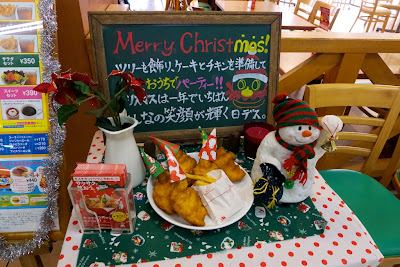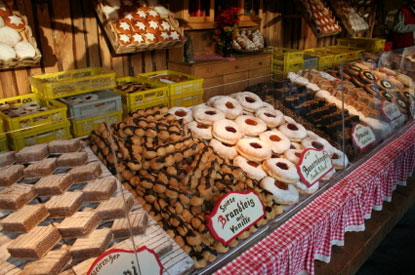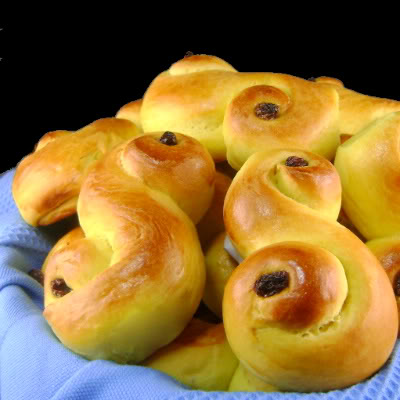
Fried Chicken 肯德基炸雞 - Japan
Japanese: "Meri Kurisumasu"

很奇怪吧,日本人歡度聖誕的佳節食品竟然是。。。快餐炸雞?!原來故事的起源是。。。
In Japan, believe it or not, fried chicken is often eaten on Christmas day . It is the busiest time of year for restaurants such as KFC and people can place orders at their local fast food restaurant in advance! All of this started in the 1970s when foreigners flocked to KFC for fried chicken, which was their only comfort food that reminded them of their home country, on Christmas day, and this tradition was quickly picked up by local Japanese as the hip and trendy thing to do!
 The traditional Japanese christmas food is christmas cake, but it's not a rich fruit cake, but is usually a sponge cake decorated with strawberries and whipped cream. This year, unfortunately, due to the huge devaluation of Japanese yen, fresh butter is of extreme short supply and many Japanese will have to face the harsh fact that christmas cake will not be easy to obtain.
The traditional Japanese christmas food is christmas cake, but it's not a rich fruit cake, but is usually a sponge cake decorated with strawberries and whipped cream. This year, unfortunately, due to the huge devaluation of Japanese yen, fresh butter is of extreme short supply and many Japanese will have to face the harsh fact that christmas cake will not be easy to obtain.
Apples - China 蘋果代表「平安」
Chinese: 聖誕快樂
最近幾年才開始接受和慶祝聖誕節的中國,以蘋果的「蘋」和平安夜的「平」諧音作為連接,將蘋果變成了聖誕節送禮的心意,果然很有中國人的風格和智慧。
In modern China, a new tradition that's becoming popular, on Christmas Eve, is giving apples. Many stores have apples wrapped up in colored paper for sale. People give apples on Christmas Eve because in Chinese Christmas Eve is called 'Ping An Ye' (which means quiet or silent night) and the word for apple in Chinese is 'Ping Guo' which sounds similar.
Christmas Cake - Britain
English: Merry Christmas

Christmas Cake - No British Christmas is complete without a Christmas Cake. This Christmas cake recipe may at first look complicated but is actually quite easy, all it needs for success is organization. Assemble and weigh all the ingredients and line the cake tin before you start and the rest is straightforward. The cake can be made up to two months before Christmas allowing time for it to mature and to be fed at regular intervals with brandy.
 British Christmas Pudding - Despite reports that the traditional British Christmas Pudding has fallen out of favor for lighter desserts, it is as popular as it ever was. The pudding is best made well in advance, by several weeks to allow it to mature. Traditionally the Christmas Pudding is made on "Stir It Up Sunday," the Sunday before Advent around the end of November.
British Christmas Pudding - Despite reports that the traditional British Christmas Pudding has fallen out of favor for lighter desserts, it is as popular as it ever was. The pudding is best made well in advance, by several weeks to allow it to mature. Traditionally the Christmas Pudding is made on "Stir It Up Sunday," the Sunday before Advent around the end of November.
Pain d'Epices Recipe - Warm spices and an unexpected shot of rich hazelnut flavor give a comforting twist to this classic French gingerbread recipe. It's wonderful accompanied with a steaming mug of coffee or hot chocolate.

Vrolijk Kerstfeest (Merry Christmas in Dutch)

One of the favorite Christmas traditions in The Netherlands is Sinterklaas, a figure from whom Santa Claus in North America is based. The Dutch celebrate Sinterklaas Eve on December 5th, often with festive family parties. It is common for both adults and children to join in the festivities!
Many families sing traditional songs and exchange gifts as they eagerly await Sinterklaas’ arrival. Children will also leave their shoes out overnight, often with carrots for Sinterklaas’ horse.

In the morning, children wake up to find the carrots gone and their shoes filled with presents from Sinterklaas—candy coins, sweet treats, small gifts, and oftentimes a chocolate letter of their first initial. These delicious chocolate letters were once a uniquely Dutch Christmas tradition, but can now be found all over the world!
Joyeux Noël (Merry Christmas), from France!

Many of us have heard of celebrating with “Yule logs” during the Christmas season, and French families enjoy the tradition in the form of a delicious bûche de Noël. Traditionally, a bûche de Noël, which literally means “Christmas log” in French, is a sponge cake and buttercream roulade that is modeled after the Yule log. The chocolate frosting is scored to resemble bark and the cake is typically embellished with exquisite meringue mushrooms, marzipan holly, and berries.
 People around the world have adopted this tradition, with many bakers increasingly offering unique twists on the traditional bûche. You may be able to find many different modern interpretations of bûches de Noël at your local pâtisserie or bakery. Or, for a fun and tasty project, you can make your own interpretation of the bûche de Noël this Christmas!
People around the world have adopted this tradition, with many bakers increasingly offering unique twists on the traditional bûche. You may be able to find many different modern interpretations of bûches de Noël at your local pâtisserie or bakery. Or, for a fun and tasty project, you can make your own interpretation of the bûche de Noël this Christmas!


Fröhliche Weihnachten (Merry Christmas), from Austria!
 Saint Nicholas brings gifts to good little boys and girls, but in Europe’s Alpine regions, Krampus is found at his side. For generations, families told scary tales of Krampus, a creature with horns and claws who frightened naughty little kids into behaving on Dec.5th, St. Nicholas Eve.
Saint Nicholas brings gifts to good little boys and girls, but in Europe’s Alpine regions, Krampus is found at his side. For generations, families told scary tales of Krampus, a creature with horns and claws who frightened naughty little kids into behaving on Dec.5th, St. Nicholas Eve.
The legend of Krampus has recently been growing in popularity, with many communities reviving Krampuslaufs (Krampus Runs), where hundreds of Krampuses run through the streets!
So, it’s not just Santa who knows if you’ve been naughty or nice—If you’ve been bad this year, you better watch out…Krampus may make an appearance!
God Jul (Merry Christmas), from Sweden!

Saint Lucia Day, celebrated on Dec. 13th, marks the beginning of the Christmas season in Sweden. Under the Julian calendar, Dec.13th used to fall on the Winter Solstice, the shortest day of the year. The Swedes celebrated Saint Lucia, whose name means “light,” as a symbol of hope and light during their harsh, long winter nights.

 Lussekatter (Lucia buns)
Lussekatter (Lucia buns)
Today, the tradition continues with festivals of light and public processions to honor Saint Lucia. In individual households, traditionally the eldest daughter wakes up early and wears a long white gown, a red ribbon around her waist, and a crown of fresh greens and lit candles.

Pepparkakor (Swedish spice cookies)
Along with her younger siblings, she serves her family coffee, lussekatter (Lucia buns), and pepparkakor (Swedish spice cookies), while singing the Lucia song.